by Satsvarupa dasa Adhikari
(ISKCON—Boston)
There have been many newspaper and magazine articles written about visits to the temples of the International Society for Krishna Consciousness. Often, a mundane newswriter reports entering a room filled with sweet aromatic incense and seeing colorful brass and wooden Deities on an altar surrounded by flowers, paintings and other paraphernalia. The newspaper reporters usually misunderstand that they are experiencing an oriental ritual in worship of Eastern gods. They do not attribute great significance to the chanting of the holy names Hare Krsna, Hare Krsna, Krsna Krsna, Hare Hare/Hare Rama, Hare Rama, Rama Rama, Hare Hare; they report only that it is repetitious or loud. They cannot convey the real transcendental meaning of the temple in terms of the devotees, the Supreme Lord and devotional service. What, then, according to transcendental authorities, is the purpose of the temple? What are the Deities? What is the meaning of kirtana, the dancing, singing and playing on musical instruments? What is the purpose of the activities going on in the temple?
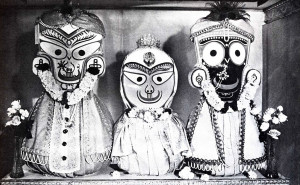 The temples of Krsna in India are like kings’ palaces, and the Supreme Lord who is staying there in the Deity form is considered to be the proprietor. Although the Supreme Lord does not need an opulent temple, the devotees take pleasure in keeping the temple clean and in worshiping the Lord in an opulent manner, and the Lord appreciates this service. Once a devotee asked His Divine Grace A.C. Bhaktivedanta Prabhupada about the dressing of the Jagannatha Deities, and he replied in a letter: “Clothing is already painted on the Jagannathas even if there is no cloth supplied, but even if Krsna is naked, that does not make any difference. But when we dress Him, our service is appreciated. On Krsna’s side, naked or dressed, He is Krsna. And from our side, if we nicely dress Krsna and we nicely feed Him, He appreciates our service, and we are certainly benefited. Krsna is the same. He does not need us to dress Him or to feed Him, but the more we serve by dressing and feeding and caring for Him, the more He appreciates the service, and the more we become Krsna conscious.”
The temples of Krsna in India are like kings’ palaces, and the Supreme Lord who is staying there in the Deity form is considered to be the proprietor. Although the Supreme Lord does not need an opulent temple, the devotees take pleasure in keeping the temple clean and in worshiping the Lord in an opulent manner, and the Lord appreciates this service. Once a devotee asked His Divine Grace A.C. Bhaktivedanta Prabhupada about the dressing of the Jagannatha Deities, and he replied in a letter: “Clothing is already painted on the Jagannathas even if there is no cloth supplied, but even if Krsna is naked, that does not make any difference. But when we dress Him, our service is appreciated. On Krsna’s side, naked or dressed, He is Krsna. And from our side, if we nicely dress Krsna and we nicely feed Him, He appreciates our service, and we are certainly benefited. Krsna is the same. He does not need us to dress Him or to feed Him, but the more we serve by dressing and feeding and caring for Him, the more He appreciates the service, and the more we become Krsna conscious.”
The Supreme Lord is not in need of big temples, and similarly the pure devotees do not need an opulent setting in which to worship. Pure devotees are prepared to live on a footpath or sleep under a tree if Krsna desires. Therefore, the temple is meant not for the Lord or the devotees but for the people in general, and especially for householders. In the Second Canto, Third Chapter, of the Srimad-Bhagavatam, which our spiritual master has published as a book entitled Pure Devotional Service: The Change in Heart, it is stated in the purport to the twenty-second verse: “Attention engaged in the service of the Lord, especially in dressing and decorating the temple, accompanied by musical kirtana and spiritual instructions from the scriptures, can alone save the common man from the hellish cinema attractions and the rubbish sex-songs broadcast everywhere by radios. If one is unable to maintain a temple at home, he should go to another’s temple where the performances are regularly executed. Visiting the temple and looking at the profusely decorated forms of the Lord, well dressed and in a well-decorated sanctified temple, naturally infuses the mundane mind with spiritual inspiration. People should visit holy places like Vrndavana where such temples and worship of the Deities are specifically maintained. Formerly all rich men like kings and rich merchants constructed such temples under the directions of expert devotees of the Lord, like the six Gosvamis, and it is the duty of the common man to take advantage of these temples and festivals observed in the holy pilgrimages by following in the footsteps of great devotees. One should not visit all these temples with sightseeing in mind, but one must go to them guided by the proper men who know the science.”
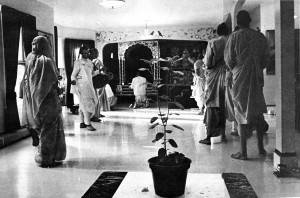 The Deities are not idols. They are incarnations of Krsna appearing in material elements. This is explained in Srila Prabhupada’s purport to Mantra Five of Sri Isopanisad: “Because He is full of inconceivable potencies, God can accept our service through any sort of medium, and He can convert His different potencies according to His own will. The unbelievers argue that the Lord cannot incarnate Himself or that He descends in a form of material energy. This argument is nullified if we accept His inconceivable potencies as realities. Even if He appears before us in the form of material energy, it is quite possible for him to convert the material energy into spiritual. The source of the energies being one and the same, Krsna, the energies can be utilized simply according to the will of that energetic source. For example, the Lord appears in the form of arca, or Deities supposedly made of earth or stone. These forms, engraved from wood or stone or any other matter, are not idols, however, as is held by the iconoclasts.” The proper understanding, then, is that because we cannot see the spiritual form of the Supreme Lord with our present senses, He may choose to appear in this material world in a form made of the material elements. But since He is the controller of both the material and spiritual energies, when He appears in such a form, it is no longer considered material. After all, since He is the supreme controller, who can restrict Him from coming in whatever form He chooses? The Lord is so pliable that He has agreed to appear before the neophyte devotees in the Deity form so that they may worship Him, feed Him and dress Him, and in this form the Lord will accept what they offer.
The Deities are not idols. They are incarnations of Krsna appearing in material elements. This is explained in Srila Prabhupada’s purport to Mantra Five of Sri Isopanisad: “Because He is full of inconceivable potencies, God can accept our service through any sort of medium, and He can convert His different potencies according to His own will. The unbelievers argue that the Lord cannot incarnate Himself or that He descends in a form of material energy. This argument is nullified if we accept His inconceivable potencies as realities. Even if He appears before us in the form of material energy, it is quite possible for him to convert the material energy into spiritual. The source of the energies being one and the same, Krsna, the energies can be utilized simply according to the will of that energetic source. For example, the Lord appears in the form of arca, or Deities supposedly made of earth or stone. These forms, engraved from wood or stone or any other matter, are not idols, however, as is held by the iconoclasts.” The proper understanding, then, is that because we cannot see the spiritual form of the Supreme Lord with our present senses, He may choose to appear in this material world in a form made of the material elements. But since He is the controller of both the material and spiritual energies, when He appears in such a form, it is no longer considered material. After all, since He is the supreme controller, who can restrict Him from coming in whatever form He chooses? The Lord is so pliable that He has agreed to appear before the neophyte devotees in the Deity form so that they may worship Him, feed Him and dress Him, and in this form the Lord will accept what they offer.
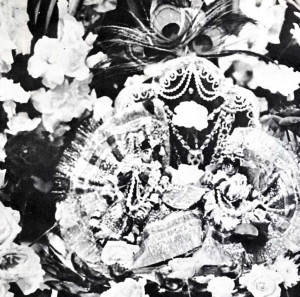 The form of the Deity is not fashioned in terms of the whim of the worshiper. It is eternal with all its paraphernalia, and this can actually be felt by a sincere devotee, but not by an atheist. For His devotee the Supreme Lord is always within reach in the Deity incarnation, whereas for the unsurrendered soul He is far away and cannot be approached. The eternal identity of the Deity is confirmed by the authority of spiritual masters who are able to see past the material energy to the spiritual form of the Lord in His incarnation as Jagannatha or Radha-Krsna. Therefore, one who is sincerely looking for spiritual union with the Supreme Lord will not refuse to worship His authorized forms in the temple.
The form of the Deity is not fashioned in terms of the whim of the worshiper. It is eternal with all its paraphernalia, and this can actually be felt by a sincere devotee, but not by an atheist. For His devotee the Supreme Lord is always within reach in the Deity incarnation, whereas for the unsurrendered soul He is far away and cannot be approached. The eternal identity of the Deity is confirmed by the authority of spiritual masters who are able to see past the material energy to the spiritual form of the Lord in His incarnation as Jagannatha or Radha-Krsna. Therefore, one who is sincerely looking for spiritual union with the Supreme Lord will not refuse to worship His authorized forms in the temple.
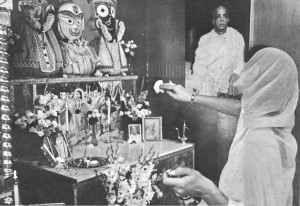 Deity worship is especially recommended for householders, those entangled in the material complications of family life. This is stated in Pure Devotional Service: The Change in Heart: “Engagement in the worship of the Deity, under the direction of the bona fide spiritual master, will greatly help the householders to purify their existence and make rapid progress in spiritual knowledge. Simple theoretical book knowledge is not sufficient for the neophyte devotee. Book knowledge is theoretical, whereas the arcana process is practical. Spiritual knowledge must be developed by a combination of theoretical and practical knowledge, and that is the guaranteed way for the attainment of spiritual perfection. The training of a neophyte in devotional service completely depends on the expert spiritual master who knows how to lead his disciple to make gradual progress back home, back to Godhead.”
Deity worship is especially recommended for householders, those entangled in the material complications of family life. This is stated in Pure Devotional Service: The Change in Heart: “Engagement in the worship of the Deity, under the direction of the bona fide spiritual master, will greatly help the householders to purify their existence and make rapid progress in spiritual knowledge. Simple theoretical book knowledge is not sufficient for the neophyte devotee. Book knowledge is theoretical, whereas the arcana process is practical. Spiritual knowledge must be developed by a combination of theoretical and practical knowledge, and that is the guaranteed way for the attainment of spiritual perfection. The training of a neophyte in devotional service completely depends on the expert spiritual master who knows how to lead his disciple to make gradual progress back home, back to Godhead.”
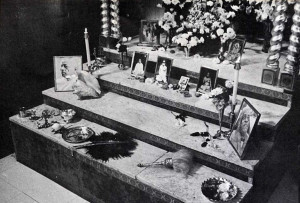 The temple itself is not located in the mundane world. Our spiritual master has declared, “This temple is not in Boston, and that temple is not in New York. They are in Vaikuntha, the spiritual planets.” The nondevotees argue that there is nothing special about the temple because God is everywhere. But the devotees of the Lord like to gather in the temple, which, because everything there is done in a manner conducive to Krsna consciousness, is an entirely transcendental place. It is said in the sastras that although he who lives in the forest is in the mode of goodness, he who lives in the city is in the mode of passion, and he who lives in the liquor shop is in the mode of ignorance, a temple is transcendental. Who, then, can object to going to the temple to see the beautiful form of the Lord surrounded by decorations and flowers? The Deities are honored in special ceremonies such as Jhulana-yatra, at which time They are swung on a swing, the Jagannatha Cart Festival, when the Deities are taken outside and wheeled on carts to the sea, and special festivals when the Radha-Krsna Deities are taken on processions in beautifully decorated carts. Since the essence of religion is to glorify God, then who can object to these transcendental ceremonies, which spread spiritual emotions to all who take part, even by offering a small flower to the Deities? Our spiritual master has stated that if one simply comes to the temple, even not understanding the spiritual nature of the form of God in the Deity, but merely appreciating the beautiful setting of the altar, and if one comes again another time and remarks, “Yes, this is very pretty; this is beautiful,” then, due to his appreciation of Krsna. he will become a devotee. In fact, Srimad-Bhagavatam, Second Canto, Chapter Three, verse 22, states: “The eyes which do not look at the symbolical representations of the Personality of Godhead Visnu are like the eyes printed on the plumes of a peacock, and the legs which do not move to the holy places where the Lord is remembered are considered to be like tree trunks.”
The temple itself is not located in the mundane world. Our spiritual master has declared, “This temple is not in Boston, and that temple is not in New York. They are in Vaikuntha, the spiritual planets.” The nondevotees argue that there is nothing special about the temple because God is everywhere. But the devotees of the Lord like to gather in the temple, which, because everything there is done in a manner conducive to Krsna consciousness, is an entirely transcendental place. It is said in the sastras that although he who lives in the forest is in the mode of goodness, he who lives in the city is in the mode of passion, and he who lives in the liquor shop is in the mode of ignorance, a temple is transcendental. Who, then, can object to going to the temple to see the beautiful form of the Lord surrounded by decorations and flowers? The Deities are honored in special ceremonies such as Jhulana-yatra, at which time They are swung on a swing, the Jagannatha Cart Festival, when the Deities are taken outside and wheeled on carts to the sea, and special festivals when the Radha-Krsna Deities are taken on processions in beautifully decorated carts. Since the essence of religion is to glorify God, then who can object to these transcendental ceremonies, which spread spiritual emotions to all who take part, even by offering a small flower to the Deities? Our spiritual master has stated that if one simply comes to the temple, even not understanding the spiritual nature of the form of God in the Deity, but merely appreciating the beautiful setting of the altar, and if one comes again another time and remarks, “Yes, this is very pretty; this is beautiful,” then, due to his appreciation of Krsna. he will become a devotee. In fact, Srimad-Bhagavatam, Second Canto, Chapter Three, verse 22, states: “The eyes which do not look at the symbolical representations of the Personality of Godhead Visnu are like the eyes printed on the plumes of a peacock, and the legs which do not move to the holy places where the Lord is remembered are considered to be like tree trunks.”
 The Deities are regularly worshiped by a performance called aratrika, which is an offering of foodstuffs, incense, flowers, a waving handkerchief, a fan and a lamp. In the ISKCON temples the Deities are worshiped with aratrika early in the morning, at 4 a.m. Then at 8 a.m. the altar is decorated and breakfast offered. At 11:30 there is again an offering of foodstuffs. At 5 p.m. the temple is opened after the Deities have rested from one to four. Then there is another aratrika ceremony. In the morning fruit and milk are offered to the Deities, and at noon dahl and chapatis and many other varieties of foodstuffs are offered. At dusk there is aratrika and again at 9 p.m. an offering of puris, vegetables, milk and sweetmeats, and after this final aratrika the Deities finally rest.
The Deities are regularly worshiped by a performance called aratrika, which is an offering of foodstuffs, incense, flowers, a waving handkerchief, a fan and a lamp. In the ISKCON temples the Deities are worshiped with aratrika early in the morning, at 4 a.m. Then at 8 a.m. the altar is decorated and breakfast offered. At 11:30 there is again an offering of foodstuffs. At 5 p.m. the temple is opened after the Deities have rested from one to four. Then there is another aratrika ceremony. In the morning fruit and milk are offered to the Deities, and at noon dahl and chapatis and many other varieties of foodstuffs are offered. At dusk there is aratrika and again at 9 p.m. an offering of puris, vegetables, milk and sweetmeats, and after this final aratrika the Deities finally rest.
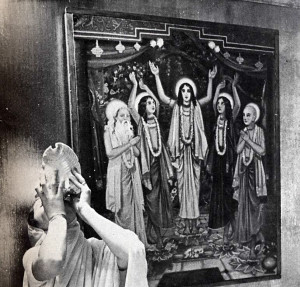 Srila Bhaktivinode Thakur has written a song of prayer for the aratrika ceremony in honor of the Supreme Lord Sri Caitanya Mahaprabhu, who is Krsna in the appearance of a devotee. His song is as follows: “Everyone come see all the glories of the beautiful arati ceremony of Lord Caitanya. This aratrika ceremony on the bank of the Ganges to receive Lord Caitanya is so beautiful that it will attract the minds of all the people of the world. Come see how Lord Caitanya is seated on the jeweled throne. To offer aratrika to Lord Caitanya, all the demigods have come, headed by Lord Brahma. See Nityananda Prabhu on the right side of Lord Caitanya, and on the left side Sri Gadadhara. Nearby is Advaita Prabhu, as well as Sri Srivasa, who is bearing the umbrella above Lord Caitanya’s head. Listen to the sounding of the conchshells, the ringing bells and the karatals. All these sounds, along with that of the sweet mrdanga, are very relishable to hear.”
Srila Bhaktivinode Thakur has written a song of prayer for the aratrika ceremony in honor of the Supreme Lord Sri Caitanya Mahaprabhu, who is Krsna in the appearance of a devotee. His song is as follows: “Everyone come see all the glories of the beautiful arati ceremony of Lord Caitanya. This aratrika ceremony on the bank of the Ganges to receive Lord Caitanya is so beautiful that it will attract the minds of all the people of the world. Come see how Lord Caitanya is seated on the jeweled throne. To offer aratrika to Lord Caitanya, all the demigods have come, headed by Lord Brahma. See Nityananda Prabhu on the right side of Lord Caitanya, and on the left side Sri Gadadhara. Nearby is Advaita Prabhu, as well as Sri Srivasa, who is bearing the umbrella above Lord Caitanya’s head. Listen to the sounding of the conchshells, the ringing bells and the karatals. All these sounds, along with that of the sweet mrdanga, are very relishable to hear.”
 This worship of Lord Caitanya can be performed with a painting of the Panca-tattva as shown here. His Divine Grace has said that in this age all that one needs to achieve spiritual perfection is to sit before this picture and chant before the lotus feet of Lord Caitanya. Srila Prabhupada has authorized this form of temple worship, and anyone who takes part will feel natural bliss. All activities and paraphernalia in temple life become meaningful by the grace of the spiritual master. Without the mercy of a spiritual master, one cannot receive devotional service in one’s heart. The progress of a neophyte devotee completely depends on the spiritual master who knows how to lead his disciple back to Godhead. The spiritual master teaches the neophyte devotee all the rules of Deity worship, and it is his duty to help his disciple fix his mind on Krsna. It is said in the third verse of Srila Visvanatha Cakravarti’s Sri Gurv-astakam: “The spiritual master is always engaged along with his disciples in the temple worship of Sri Sri Radha and Krsna. I offer my respectful obeisances unto the lotus feet of such a spiritual master.”
This worship of Lord Caitanya can be performed with a painting of the Panca-tattva as shown here. His Divine Grace has said that in this age all that one needs to achieve spiritual perfection is to sit before this picture and chant before the lotus feet of Lord Caitanya. Srila Prabhupada has authorized this form of temple worship, and anyone who takes part will feel natural bliss. All activities and paraphernalia in temple life become meaningful by the grace of the spiritual master. Without the mercy of a spiritual master, one cannot receive devotional service in one’s heart. The progress of a neophyte devotee completely depends on the spiritual master who knows how to lead his disciple back to Godhead. The spiritual master teaches the neophyte devotee all the rules of Deity worship, and it is his duty to help his disciple fix his mind on Krsna. It is said in the third verse of Srila Visvanatha Cakravarti’s Sri Gurv-astakam: “The spiritual master is always engaged along with his disciples in the temple worship of Sri Sri Radha and Krsna. I offer my respectful obeisances unto the lotus feet of such a spiritual master.”
 As far as the chanting of Hare Krsna is concerned, it is the prime benediction of the Krsna consciousness movement, and therefore the temples vibrate with the transcendental sound of the holy names. The chanting is purely spiritual; it is the cry of the individual soul for the Supreme Personality of Godhead, Sri Krsna, like the cry of a child for its mother. Chanting the mahamantra is the prescribed method of worship for this age. “In this age the sacrifice of holding congregational chanting of the holy name of the Lord is the prescribed method.” (Bhaktivedanta purport to Srimad-Bhagavatam, 1.1.14).
As far as the chanting of Hare Krsna is concerned, it is the prime benediction of the Krsna consciousness movement, and therefore the temples vibrate with the transcendental sound of the holy names. The chanting is purely spiritual; it is the cry of the individual soul for the Supreme Personality of Godhead, Sri Krsna, like the cry of a child for its mother. Chanting the mahamantra is the prescribed method of worship for this age. “In this age the sacrifice of holding congregational chanting of the holy name of the Lord is the prescribed method.” (Bhaktivedanta purport to Srimad-Bhagavatam, 1.1.14).
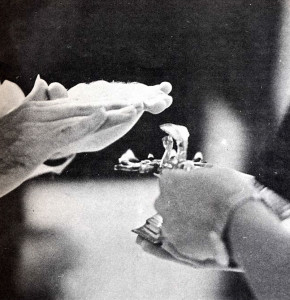 The chanting of the Hare Krsna mantra is eternal, beyond history, but it was first delivered to this planet by the great sage Narada Muni, and Lord Caitanya Mahaprabhu, who is accepted by the Brahma-sampradaya (the disciplic succession of Krsna conscious spiritual masters) as Krsna Himself, gave special impetus to this movement. Lord Caitanya gave evidence from the Brhan-Naradiya Purana concerning chanting in this present age: harer nama harer nama harer namaiva kevalam kalau nasty eva nasty eva nasty eva gatir anyatha: “Chant the holy name, chant the holy name, chant the holy name! There is no other means of success in God realization for this age of Kali.” In the age of Kali, the age of quarrel and hypocrisy, it is not possible to perform difficult penances or austerities in order to obtain spiritual life. “In this iron age of quarrel, men almost always have short lives. O learned one, not only that, but they are also very lazy, misguided, unlucky, and above all, always disturbed.” (Bhag. 1.1.10) “[But] living beings who are entangled in the meshes of birth and death can be freed immediately by even unconsciously chanting the holy name of Krsna, which is feared even by fear personified.” (Bhag. 1.1.14) We cannot overestimate the benefit made available to the average man in the age of Kali by the congregational chanting and Deity worship afforded by the lSKCON temples.
The chanting of the Hare Krsna mantra is eternal, beyond history, but it was first delivered to this planet by the great sage Narada Muni, and Lord Caitanya Mahaprabhu, who is accepted by the Brahma-sampradaya (the disciplic succession of Krsna conscious spiritual masters) as Krsna Himself, gave special impetus to this movement. Lord Caitanya gave evidence from the Brhan-Naradiya Purana concerning chanting in this present age: harer nama harer nama harer namaiva kevalam kalau nasty eva nasty eva nasty eva gatir anyatha: “Chant the holy name, chant the holy name, chant the holy name! There is no other means of success in God realization for this age of Kali.” In the age of Kali, the age of quarrel and hypocrisy, it is not possible to perform difficult penances or austerities in order to obtain spiritual life. “In this iron age of quarrel, men almost always have short lives. O learned one, not only that, but they are also very lazy, misguided, unlucky, and above all, always disturbed.” (Bhag. 1.1.10) “[But] living beings who are entangled in the meshes of birth and death can be freed immediately by even unconsciously chanting the holy name of Krsna, which is feared even by fear personified.” (Bhag. 1.1.14) We cannot overestimate the benefit made available to the average man in the age of Kali by the congregational chanting and Deity worship afforded by the lSKCON temples.
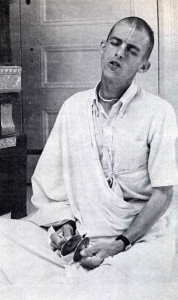 The chanting is glorification of God. There is a difference between American food and Indian food, yet the purpose of both is the same: to satisfy our hunger. Similarly, there are different rituals in churches and temples, but the goal is the same: to achieve love of God. If the goal is otherwise, then that is not real religion. The chanting of Hare Krsna is the essence of religion—to glorify God. Who can object? And what is the harm in chanting? The chanting is a prayer to the Supreme Lord to please take the chanter out of the inferior energy, into the spiritual. It is a plea for transcendental loving service unto God. Once, when asked what a man should pray for, His Divine Grace A.C. Bhaktivedanta Swami Prabhupada answered, “We should pray, ‘Dear God, please let me love you.’ ” And so the musical instruments, mrdanga drums and hand cymbals are used in glorification of God, and the dancing is a beginning stage of ecstasy. Anyone may take part in the chanting, even a child. It is so nice.
The chanting is glorification of God. There is a difference between American food and Indian food, yet the purpose of both is the same: to satisfy our hunger. Similarly, there are different rituals in churches and temples, but the goal is the same: to achieve love of God. If the goal is otherwise, then that is not real religion. The chanting of Hare Krsna is the essence of religion—to glorify God. Who can object? And what is the harm in chanting? The chanting is a prayer to the Supreme Lord to please take the chanter out of the inferior energy, into the spiritual. It is a plea for transcendental loving service unto God. Once, when asked what a man should pray for, His Divine Grace A.C. Bhaktivedanta Swami Prabhupada answered, “We should pray, ‘Dear God, please let me love you.’ ” And so the musical instruments, mrdanga drums and hand cymbals are used in glorification of God, and the dancing is a beginning stage of ecstasy. Anyone may take part in the chanting, even a child. It is so nice.
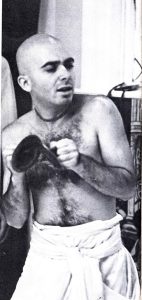 The temple is also used for lectures and classes in the transcendental science of Krsna consciousness. Due to the unbreakable system of disciplic succession, the scriptural elaborations and expositions on the philosophy of Krsna consciousness (as found in Vedanta-sutra, Bhagavad-gita, the Upanisads, Srimad-Bhagavatam, etc.) are the most voluminous, exacting and consistent of any religious culture in the world. As stated in Bhagavad-gita, the science of Krsna consciousness, devotional service unto God, is the king of knowledge. This science teaches one that the material body is merely temporary, whereas one’s real identity is as an eternal, blissful spirit soul who is a part and parcel of God. It teaches us our eternal relationship with the Supreme Personality of Godhead as His eternal servants. In daily classes on the Vedic literatures, perfect knowledge is received by submissive aural reception. As stated in Srimad-Bhagavatam, 1.2.18: “If a candidate for devotional service regularly attends classes in the Srimad-Bhagavatam or renders service unto pure devotees, all that is inauspicious in his heart becomes destroyed almost to nil, and thus loving service unto the Personality of Godhead … comes to be an irrevocable fact.”
The temple is also used for lectures and classes in the transcendental science of Krsna consciousness. Due to the unbreakable system of disciplic succession, the scriptural elaborations and expositions on the philosophy of Krsna consciousness (as found in Vedanta-sutra, Bhagavad-gita, the Upanisads, Srimad-Bhagavatam, etc.) are the most voluminous, exacting and consistent of any religious culture in the world. As stated in Bhagavad-gita, the science of Krsna consciousness, devotional service unto God, is the king of knowledge. This science teaches one that the material body is merely temporary, whereas one’s real identity is as an eternal, blissful spirit soul who is a part and parcel of God. It teaches us our eternal relationship with the Supreme Personality of Godhead as His eternal servants. In daily classes on the Vedic literatures, perfect knowledge is received by submissive aural reception. As stated in Srimad-Bhagavatam, 1.2.18: “If a candidate for devotional service regularly attends classes in the Srimad-Bhagavatam or renders service unto pure devotees, all that is inauspicious in his heart becomes destroyed almost to nil, and thus loving service unto the Personality of Godhead … comes to be an irrevocable fact.”
The disciples of His Divine Grace A.C. Bhaktivedanta Swami Prabhupada are so fortunate that they can partake in the transcendental activities in the temple, and we all acknowledge that the pure devotee has given us all means to reach Krsna. As disciples, we invite everyone to come to the Krsna consciousness temples and take part in the feasts, classes and other programs.

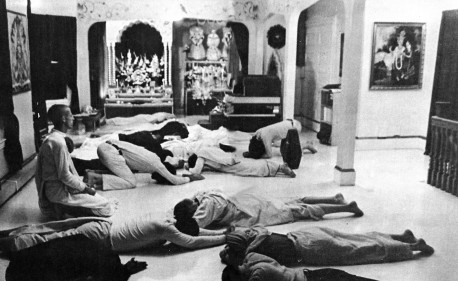


Leave a Reply